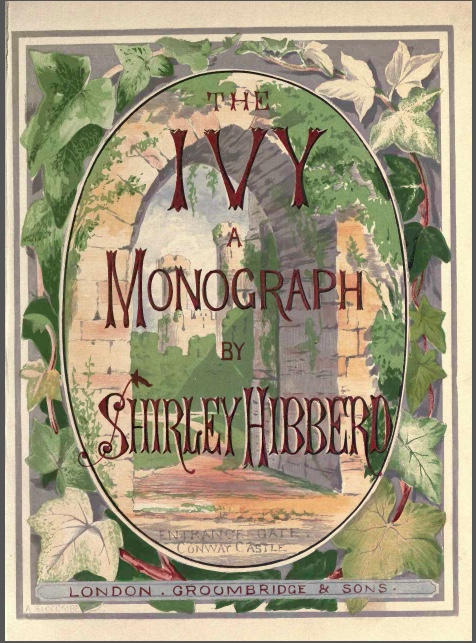By Dawn Bazely

The first Advent Botany post, on December 1st, 2014, was about ivy, that most classic of British festive season species. English Ivy, as it’s known in North America (Hedera helix) is an evergreen woody climbing plant. It is native to much of Europe and Asia, and it was introduced to North America as a garden plant, where it promptly jumped over the fence. Ivy is considered invasive in Washington State, USA and in British Columbia, Canada. It also does very well in my Toronto front garden.
Ivy always makes me think of 19th century England, perhaps because it’s so common in Victorian North Oxford, where I lived for 6 years. We know that ivy was a popular garden plant during Victorian times because James Shirley Hibberd (1825 – 1890), the very successful gardening writer and journalist (Wilkinson 2012), devoted an entire book to it, called:
The Ivy, a monograph: comprising the history, uses, characteristics, and affinities of the plant, and a descriptive list of all the garden ivies in cultivation (1872).

Hibberd gives the reader lots of “historical and literary memoranda” about ivy, including some musings on its roles at Christmas, and in tavern and pub signage!

“The holly and the ivy have, from the earliest times held the mastery in providing the green garniture of the Christmas feast, and in many a bright old carol are their virtues celebrated in connection with the great season of rejoicing in the Christian year.” p.11
General literacy increased during Victorian times, as a result of the spread of charitable and private schools,while the Elementary Education Act (1870) mandated state schooling for everyone. This helped to create a demand for Hibberd’s affordable colour printed gardening books and magazines. His prolific writing was aimed at amateur gardeners: people with low to middle incomes, who were gardening in small, city gardens (Wilkinson 1998). Many of Hibberd’s readers would not have had a paid professional gardener.
Today, the modern technologies of digitization and the internet are allowing us to experience British Victorian era botany. We can all download and read a digitized copy of Hibberd’s The Ivy, from the University of California Libraries via the Biodiversity Heritage Library.

References:
Shirley Hibberd, J. 1872. The Ivy, a monograph. London, Groombridge and sons. https://doi.org/10.5962/bhl.title.17338
Wilkinson, A. 1998. The preternatural gardener: The Life of James Shirley Hibberd (1825-90). Garden History. 26: 153-175. http://www.jstor.org/stable/1587201
Wilkinson, A. 2012. Shirley Hibberd, The Father of Amateur Gardening: His Life and Works 1825–1890. Cortex Design Publishers. ISBN 978-0-956-809605
WEBSITES referenced in this post:
- http://blogs.reading.ac.uk/crg/2014-botanical-advent-calendar/
- https://www.nwcb.wa.gov/weeds/english-ivy
- http://bcinvasives.ca/invasive-species/identify/invasive-plants/english-ivy/
- https://en.wikipedia.org/wiki/North_Oxford
- https://en.wikipedia.org/wiki/Shirley_Hibberd
- http://www.shirleyhibberd.co.uk/index.html
- https://en.wikipedia.org/wiki/Education_in_England
- https://en.wikipedia.org/wiki/History_of_education_in_England
Photos:
- Hibberd. The Ivy – Book cover
- Hibberd The Ivy – Title page
- Hibberd The Ivy – frontispiece
- Hibberd The Ivy – p. 62
- Hibberd The Ivy – p 78
Editor’s notes

Checking the University of Reading Library, I see that we have a copy of Hibberd’s monograph ‘Presented by Lord Winchilsea, Dec. 1931’ bearing the ‘Winchilsea and Nottingham. 1902 (Armorial bookplate)’ – figured here (thank you Erika Delbecque)
For an update on Hedera taxonomy check Advent Botany 2014 Day 1
